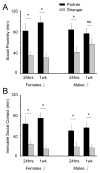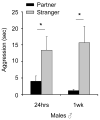Evaluation of two automated metrics for analyzing partner preference tests
- PMID: 19539647
- PMCID: PMC2747247
- DOI: 10.1016/j.jneumeth.2009.06.010
Evaluation of two automated metrics for analyzing partner preference tests
Abstract
The partner preference test (PPT) is commonly used to examine sexual and social preferences in rodents. The test offers experimental subjects a choice between two stimulus animals, and time spent with each is used to calculate a preference score. In monogamous prairie voles (Microtus ochrogaster), the PPT has been paramount to the study of pair bonding. Although powerful, use of the PPT in voles has depended primarily on human manual scoring. Manual scoring is time-consuming and is susceptible to bias and fatigue, limiting the use of the PPT in high-throughput studies. Here we compared manual scoring (real-time and 16x) and two automated scoring metrics: "social proximity" and "immobile social contact". We hypothesized that "immobile social contact" would provide data most comparable to manually scored "huddling", and thus be the most sensitive measure of partner preference in prairie voles. Each automated metric produced data that highly correlated with manual scoring (R>0.90); however, "immobile social contact" more closely reflected manually scored huddling (R=0.99; P<0.001). "Social proximity" and "immobile social contact" were then used to detect group partner preferences in four data sets that varied by cohabitation length and sex. "Immobile social contact" revealed a significant partner preference in each data set; "social proximity" detected partner preferences in only three of the four. Our results demonstrate the utility of automated systems in high-throughput PPTs, and further confirm that automated systems capable of scoring "immobile social contact" yield results indistinguishable from manual scoring.
Figures





References
-
- Aragona BJ, Liu Y, Yu YJ, Curtis JT, Detwiler JM, Insel TR, Wang Z. Nucleus accumbens dopamine differentially mediates the formation and maintenance of monogamous pair bonds. Nat Neurosci. 2006;9:133–139. - PubMed
-
- Baum MJ, Erskine MS, Kornberg E, Weaver CE. Prenatal and neonatal testosterone exposure interact to affect differentiation of sexual behavior and partner preference in female ferrets. Behav Neurosci. 1990;104:183–198. - PubMed
-
- Carter CS, DeVries AC, Getz LL. Physiological substrates of mammalian monogamy: the prairie vole model. Neurosci Biobehav Rev. 1995;19:303–314. - PubMed
Publication types
MeSH terms
Grants and funding
LinkOut - more resources
Full Text Sources

